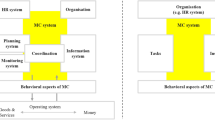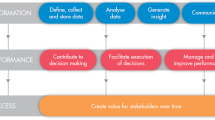Abstract
The last two decades have witnessed a significant increase in discussions about the different dimensions of knowledge and knowledge management (KM). This is especially true in the construction context. Many factors have contributed to this growing interest including globalisation, increased competition, diffusion of new ICTs (information and communication technologies) and new procurement routes, among others. There are a range of techniques and technologies that can be used for KM in construction organisations. The use of techniques for KM is not new, but many technologies for KM are fairly new and still evolving. This paper begins with a review of different KM techniques and technologies and then reports the findings of case studies of selected U.K. construction organisations, carried out with the aim of establishing what tools are currently being used in U.K. construction organisations to support knowledge processes. Case study findings indicate that most organisations do not adopt a structured approach for selecting KM technologies and techniques. The use of KM techniques is more evident compared to KM technologies. There is also reluctance among construction companies to invest in highly specialised KM technologies. The high costs of specialist KM technologies are viewed as the barrier to their adoption. In conclusion, the paper advocates integrated use of KM techniques and technologies in construction organisations.

Similar content being viewed by others
References
Al-Ghassani AM (2002) Literature review on KM tools. Technical Report, July 2002, Department of Civil and Building Engineering, Loughborough University, UK.
Anumba CJ, Bloomfield D, Faraj I and Jarvis P (2000) Managing and Exploiting Your Knowledge Assets: Knowledge Based Decision Support Techniques for the Construction Industry. BR382, Construction Research Communications Ltd., UK.
Brown JS and Duguid P (1991) Organizational learning and communities of practice: towards a unified view of working, learning and organization. Organization Science 2 (1), 40–57.
Carrillo PM (2001) Mergers and acquisitions in the construction industry: an exploratory study. PhD Thesis, Loughborough University.
Carrillo PM, Robinson HS, Al-Ghassani AM and Anumba CJ (2002) Survey of knowledge management in construction. KnowBiz Project Technical Report, Department of Civil and Building Engineering, Loughborough University, UK.
Chataway JC, Gault F, Quintas P and Wield DV (2003) Dealing with the knowledge divide. In Monitoring Digital Divides and Beyond (SCIADAS G, Ed), Orbicom, Montreals.
Davenport TH and Prusak L (1998) Working Knowledge: How Organisations Manage What They Know. Harvard Business School Press, Boston.
Egan Sir J (1998) Rethinking construction. [online], Available from: http://www.construction.detr.gov.uk/cis/rethink/index.htm (Accessed 05 November 2003).
Egbu CO (1999) The role of knowledge management and innovation in improving construction competitiveness. Building Technology and Management Journal 25, 1–10.
Egbu CO (2000a) Knowledge management in construction SME's: coping with the issues of structure, culture, commitment and motivation. Proceedings of the 16th Annual Conference of ARCOM (AKINTOYE A, Ed), 6–8 September, Glasgow Caledonian University, ARCOM, Reading, UK, Vol. 1, pp 83–92.
Egbu CO (2000b) The Role of IT in Strategic Knowledge Management and its Potential in the Construction Industry UK National Conference on Objects and Integration for Architecture, Engineering, and Construction, 13–14th March, BRE, Watford, UK.
Egbu C and Robinson H (2005) Construction in a Knowledge-Based Industry. In Knowledge Management in Construction (ANUMBA CJ, EGBU C and CARRILLO P Eds), Blackwell Publishing, Oxford, UK.
Fruchter R. (2002) Metaphors for knowledge capture, sharing and reuse. In Proceedings of eWork and eBusiness in Architecture, Engineering and Construction, ECPPM Conference 2002 (TURK Z and SCHERER R, Eds), pp 17–26. Taylor and Francis, London.
Gallupe RB (2001) Knowledge management systems: surveying the landscape. International Journal of Management Reviews 3 (1), 61–67.
Haag S, Cummings M and Dawkins J (1998) Management Information Systems for the Information Age. McGraw-Hill, USA.
Haag S and Keen P (1996) Information Technology: Towards Advantage Today. McGraw-Hill, USA.
Hansen MT, Nohria N and Tierney T (1999) What's your strategy for managing knowledge? Harvard Business Review 77 (2), 106–116.
Hari S, Egbu CO and Kumar B (2003) Knowledge management for small and medium enterprises – issues concerning culture and information technology. In Proceedings of the 2nd International Conference on Innovation in Architecture, Engineering and Construction, 25–27 June 2003, Loughborough, UK, pp 569–580, Millpress Science Publishers, Rotterdam, The Netherlands.
von Hippel E (1994) “Sticky information” and the locus of problem solving: implications for innovation. Management Science 40 (4), 429–439.
Kamara JM, Anumba CJ and Carrillo PM (2002) A CLEVER approach to selecting a knowledge management strategy. International Journal of Project Management 20 (3), 205–211.
Kanter J (1999) Knowledge management: practically speaking. Information Systems Management 16 (4), 7–15.
KPMG Management Consulting (1998) Knowledge Management Research Report. KPMG Management Consulting, Available from http://www.knowledgebusiness.com.
Lang JC (2001) Managerial concerns in knowledge management. Journal of Knowledge Management 5 (1), 43–57.
Latham Sir M (1994) Constructing the team. Final report of the government/industry review of procurement and contractual arrangements in the UK construction industry, HMSO, London.
Lave J and Wenger E (1991) Situated Learning: Legitimate Peripheral Participation. Cambridge University Press, Cambridge.
Lucca J, Sharda R and Weiser M (2000) Coordinating technologies for knowledge management in virtual organisations. Proceedings of the Academia/Industry Working Conference on Research Challenges CAIWORC'00, 27–29 April, Buffalo, New York.
Nissen M, Kamel M and Sengupta K (2000) Integrated analysis and design of knowledge systems and processes. Information Resources Management Journal 13 (1), 24–43.
Polanyi M (1958) Personal Knowledge. Routledge and Kegan Paul, London.
Polanyi M (1966) The Tacit Dimension. Doubleday, Garden City, NY.
Quintas P (2005) The nature and dimensions of knowledge management. In Knowledge Management in Construction (ANUMBA CJ, EGBU C and CARRILLO P, Eds), pp 10–30, Blackwell Publishing, Oxford, UK.
Robinson HS, Carrillo PM, Anumba CJ and Al-Ghassani AM (2001) Linking knowledge management strategy to business performance in construction organisations. In Proceedings of the 17th Annual Conference of the Association of Researchers in Construction Management (ARCOM) (AKINTOYE A, Ed.), University of Salford 5–7 September 2001, ARCOM, Reading, UK, Vol. 2, pp 577–586.
Ruggles R (1997) Knowledge tools: using technology to manage knowledge better. Working paper for Ernst and Young, [online], Available from: http://www.businessinnovation.ey.com/mko/html/toolsrr.html Accessed 16 August 2000.
Santosus M and Sarmacz J (2001) The ABCs of knowledge management. [online], Available from: http://www.cio.com/research/knowledge/edit/kmabcs.html Accessed 17 January 2004.
Scarbrough H, Swan J and Preston J (1999) Knowledge Management a Literature Review – Issues in People Management. London Institute of Personnel and Development, London.
Sheehan T and Poole D (2005) The Business Case for Knowledge Management. In Knowledge Management in Construction (ANUMBA CJ, EGBU C and CARRILLO P, Eds), pp 60–62, Blackwell Publishing, Oxford, UK.
Skyrme DJ and Amidon DA (1997) A Report on: Creating the Knowledge-Based Business. Business Intelligent Limited, London.
Storey J and Barnet E (2000) Knowledge management initiatives: learning from failure. Journal of Knowledge Management 4 (2), 145–156.
TFPL Ltd. (1999) A Report on: Skills for Knowledge Management – Building a Knowledge Economy, 1st edn, TFPL Ltd., London.
Tsui E (2002a) Technologies for Personal and Peer to Peer (P2P) Knowledge Management, CSC Leading Edge Forum Technology Grant Report http://www2.csc.com/lef/programs/grants/finalpapers/tsui_final_P2PKM.pdf (06/06/02).
Tsui E (2002b) Tracking the role and evolution of commercial knowledge management software. In Handbook on Knowledge Management (HOLSAPPLE CW, Ed), pp 5–28, Springer-Verlag, Berlin/Heidelberg.
Tiwana A (2000) The Knowledge Management Toolkit. Prentice-Hall Inc., New Jersey, USA.
Yin RK (1994) Case Study Research: Design and Methods, 2nd edn, Sage, Thousand Oaks, CA.
Author information
Authors and Affiliations
Corresponding author
Rights and permissions
About this article
Cite this article
Ruikar, K., Anumba, C. & Egbu, C. Integrated use of technologies and techniques for construction knowledge management. Knowl Manage Res Pract 5, 297–311 (2007). https://doi.org/10.1057/palgrave.kmrp.8500154
Received:
Accepted:
Published:
Issue Date:
DOI: https://doi.org/10.1057/palgrave.kmrp.8500154




